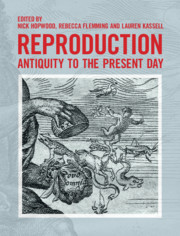Book contents
- Reproduction
- Frontispiece
- Reproduction
- Copyright page
- Dedication
- Contents
- Exhibits
- Illustrations
- Notes on the Frontispieces
- Contributors
- Acknowledgements
- Introduction
- Part I Inventing Generation
- Part II Generation Reborn and Reformed
- Part III Inventing Reproduction
- Part IV Modern Reproduction
- 27 Breeding Farm Animals and Humans
- 28 Eggs and Sperm as Germ Cells
- 29 Movements to Separate Sex and Reproduction
- 30 Fertility Transitions and Sexually Transmitted Infections
- 31 Modern Infertility
- 32 Modern Ignorance
- 33 Imperial Encounters
- Part V Reproduction Centre Stage
- Epilogue
- Exhibits
- Select Bibliography
- Index
27 - Breeding Farm Animals and Humans
from Part IV - Modern Reproduction
Published online by Cambridge University Press: 16 November 2018
- Reproduction
- Frontispiece
- Reproduction
- Copyright page
- Dedication
- Contents
- Exhibits
- Illustrations
- Notes on the Frontispieces
- Contributors
- Acknowledgements
- Introduction
- Part I Inventing Generation
- Part II Generation Reborn and Reformed
- Part III Inventing Reproduction
- Part IV Modern Reproduction
- 27 Breeding Farm Animals and Humans
- 28 Eggs and Sperm as Germ Cells
- 29 Movements to Separate Sex and Reproduction
- 30 Fertility Transitions and Sexually Transmitted Infections
- 31 Modern Infertility
- 32 Modern Ignorance
- 33 Imperial Encounters
- Part V Reproduction Centre Stage
- Epilogue
- Exhibits
- Select Bibliography
- Index
Summary
- Type
- Chapter
- Information
- ReproductionAntiquity to the Present Day, pp. 397 - 412Publisher: Cambridge University PressPrint publication year: 2018
- 3
- Cited by



